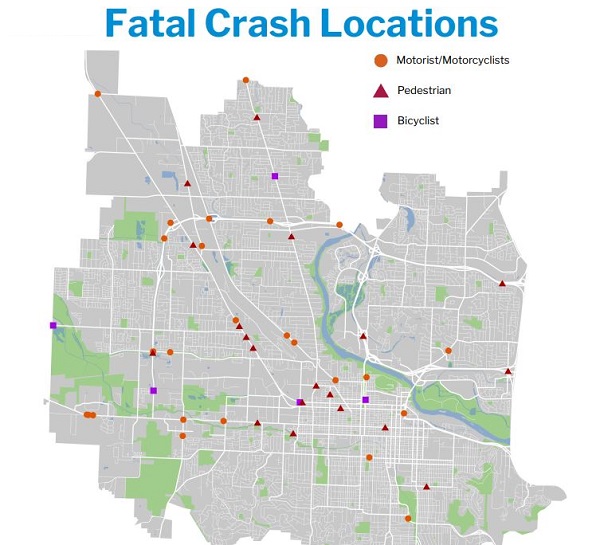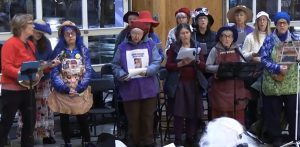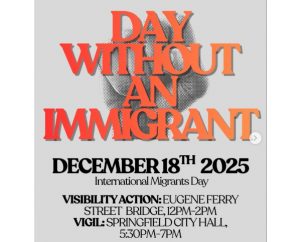After a record 22 deaths last year, Eugene considers ways to reduce traffic fatalities
8 min read
Presenter: Transportation-related deaths hit an all-time high in Eugene in 2024, with 22 fatal traffic crashes. The dead included 10 pedestrians and one bicyclist. Eugene has now recorded the highest number of fatalities for any three-year period, with 50 deaths from 2022-2024. At the Active Transportation Committee Aug. 14, Transportation Planner Logan Telles:
Logan Telles (Eugene, transportation planner): And you know, some years prior, it was more normal for us to have like five or six in a given year. So a really dramatic increase: 22 in the Eugene urban growth boundary.
[00:00:39] If we want to get into the fatal crash report, you can kind of see how fatal crashes for peds and also fatal crashes for people driving have seen the most significant increases, particularly the pedestrians.
[00:00:57] 2023, we saw more fatal bike crashes than we typically do. But it doesn’t seem like we’re seeing the same spike as with the crashes involving people walking. So that’s at least a little bit of a relief. I mean, one’s too many. But that is what we’ve seen so far through 2024.
[00:01:15] To give you kind of a high-level idea of like the distribution of these incidents throughout town, they’re pretty spread out. Highway 99 has been a big problem for us in recent years, especially for pedestrian-involved crashes.
[00:01:30] Talking about some of the characteristics of the locations where we’ve seen these crashes: Once again, arterials are a really big theme and that continues to be true for this 2022-2024 data. And once again, high-speed roadways are particularly prominent.
[00:01:48] I think that some people are surprised to see such a large number of the pedestrian-involved crashes being on that 55-mile-per-hour-plus category. And like I said, some of that is not just necessarily on freeways, but also Northwest Expressway is 55, portions of West 11th as you get really far west in the UGB area are 55, so that’s something that we’re seeing.
[00:02:17] The most common type of location, were straight roadway segments. So we’re not necessarily talking as much about curves, which I think surprises some folks.
[00:02:26] Intersections are also obviously of concern, but don’t make up as many as just those kind of more straight shots that people are driving a bit faster on. And that kind of matches up with a lot of these locations being on arterials, you know, our arterials are generally pretty straight throughways.
[00:02:42] And just kind of one interesting thing that’s showing up in the numbers: A lot of the driver- and motorcyclist-involved collisions involved roadway departure, which is normally thought of as being a bit more of like a rural crash type, you know, people on a rural road, there’s a curve in the road, they go off the road.
And so it’s interesting to see so many of the fatal crashes involving drivers and motorcyclists being about people leaving the roadway, crashing into something like a traffic signal or a utility pole or a tree. So that’s an interesting thing that’s showing up.
[00:03:20] Let’s talk about drugs and alcohol again. During this time period, it was also a really significant contributing factor. Yeah, really impactful, you know, impactful for everyone, but also especially for the fatal crashes involving people walking and biking, you know, you often see it’s a really significant contributing factor.
[00:03:40] Active Transportation Committee member: Has there been an increase in the number of vehicles on the road in this time period or any other contributing factors?
[00:03:46] Logan Telles (Eugene, transportation planner): If we have had an increase in travel volumes, not to the extent that would make up for such a significant increase in our fatalities.
Yeah, I think on an overall big picture scale, if I had to just throw out some of my theories for why we’re seeing such a big increase: People are speeding, like even more so than they were before the pandemic, for instance. So vehicle speeds are a really big contributing factor.
[00:04:18] As a lot of us know, vehicle manufacturers have increasingly made cars and trucks bigger, and so they’re heavier. And so there’s more momentum when a crash does occur, and that’s more likely to kill or seriously injure somebody.
[00:04:33] I think another big factor that I think is impactful in all of this is our housing crisis is kind of intersecting with our traffic safety crisis, especially for pedestrian-involved crashes. It’s hard to definitively quantitatively say what portion of the folks affected were unhoused community members, because housing status isn’t formally recorded as a data point on the crash report forms.
But I will say just talking with EPD about these incidents, a lot of folks who are affected by the pedestrian crash increase are unhoused community members.
[00:05:12] A lot of them are, you know, Highway 99, you know, around service centers and social service providers and housing facilities that are helping house those folks temporarily. And so that’s a big, you know, kind of intersection of two societal issues we’re having.
[00:05:27] And then on top of that, I think that our community’s challenges with substance use and addiction are contributing as well. I’m not a public health professional, but I think that it stands to reason that that also probably got worse during the pandemic and the shutdown and everybody’s isolated. And so that’s another kind of intersection between our traffic safety issues and like a broader societal challenge that we’re having.
[00:05:54] Presenter: Active Transportation Committee Member Charlie Loeb:
[00:05:58] Charlie Loeb (Active Transportation Committee): All three of those things you mentioned are notably things that transportation planners don’t really address.
[00:06:04] Logan Telles (Eugene, transportation planner): It is really challenging…
[00:06:06] Jody Trendler is going to be leading a corridor study for both River Road and Highway 99. But I think the Highway 99 one in particular is a great opportunity to do community engagement that is targeted to the social service providers on Highway 99. I think that’s a really great opportunity for us to try to work on some of those issues, however we can.
[00:06:32] I mean, it’s not to say that’s the only option. Every year, every fall, we give away a bunch of bike lights, reflective materials. We give away high visibility beanies with reflector woven in the fabric. And we target a lot of the social service providers that are serving unhoused community members to like give to their clientele. And we distributed materials to those providers on Highway 99 last year and we’ll do it again this year. And that’s not going to fix the problem necessarily, but it’s one small thing that we’re doing right now.
[00:07:10] And yeah, and I think especially in areas where we’re seeing those hot spots of pedestrian-related crashes involving unhoused community members like on Highway 99, something like lighting upgrades is still a great option. Even in unpredictable circumstances, better lighting is always going to help. You know, it’s never going to hurt.
[00:07:31] Darkness is an overrepresented factor and it’s most impactful for people who are walking and people who are biking, which isn’t necessarily a surprise.
[00:07:41] Our paving project that one of our engineers is kind of designing right now was already going to do LED upgrades on Highway 99. And it sounds like we’ve come to the collective decision that we’re going to do brighter than standard lighting there to help with this issue. So hopefully that is something that helps it, helps a bit, you know.
[00:08:03] And yeah, the only demographic data I can pull from the source I use for this is age, sex. A lot of the crash victims were male.
[00:08:17] Some people would expect like a really significant representation for older folks or younger folks, but at least with the fatal crashes during this three-year period, looks like 20% of them were 65 or older. And thankfully, we didn’t have too many affecting minors. Obviously any a year is too many, but during this time period, 4% were under the age of 18.
[00:08:17] Some people would expect like a really significant representation for older folks or younger folks, but at least with the fatal crashes during this three-year period, looks like 20 % of them were 65 or older. And thankfully, we didn’t have too many affecting minors. Obviously any a year is too many, but during this time period, 4% were under the age of 18.
[00:08:43] Presenter: They’re not yet keeping reliable data on housing status. Logan Telles:
[00:08:48] Logan Telles (Eugene, transportation planner): For me, like as someone who’s working on these issues, when I think about like the question of like why it matters, I think about like the heightened vulnerability of like that demographic ’cause they spend so much time in closer proximity to the roadway than the average person.
[00:09:06] And then I also think about, ’cause we talked about like the social service provider sites, but aside from the social service provider sites, then you think about other types of destinations like bottle drop centers or areas where we know we’re having a lot of urban camping, which is also tricky because that can move around. And then it’s like, how do you plan infrastructure improvements around where urban camping is moving around? But yeah, so that’s kind my takeaway for like how that information could or couldn’t be useful.
[00:09:40] Presenter: Charlie Loeb:
[00:09:41] Charlie Loeb (Active Transportation Committee): Logan, my sense is that the reason this has been done is for grant eligibility, you know, the reason it’s been done at this time but this is obviously, you know, a big concern for the folks who are part of ATC and is there anything that we could or should be doing or asking for that can help move us to a point where there’s fewer fatal and serious crashes? How can we put more action in the action plan?
[00:10:10] Presenter: Logan Telles:
[00:10:12] Logan Telles (Eugene, transportation planner): Yeah, that’s a tough question. Yeah, I mean, yes, maybe there’s an opportunity to like coordinate more with the capital project subcommittee on high-crash corridors.
[00:10:23] Charlie Loeb (Active Transportation Committee): All right, one last thing from Sue.
[00:10:26] Sue: Can you create something like a school zone around something like that section of Highway 99, where, you know, there’s personal services zone?
[00:10:35] Logan Telles (Eugene, transportation planner): That would be nice. There isn’t like a mechanism like that in place right now…
[00:10:39] The way that speed limit setting happens in Oregon is ODOT regulates all speed limits regardless of whether we own the roadway. But we as the roadway authority can request a speed zone investigation from ODOT. And then they do a very specific methodology for determining what the recommended speed limit is there.
[00:10:59] So we always have the option of, if we feel like a speed limit is not appropriate for a particular location, we can ask for a speed zone investigation.
[00:11:09] I will say that ODOT has a really limited number of staff doing those. And so we try to be mindful about the number of requests we put in in a given year, because if we overload them, it’s just we’re not going to get results back. But that is an option we can consider in some locations.
[00:11:29] Presenter: The Active Transportation Committee suggests slowing traffic on Highway 99 with a personal services zone, as Eugene again falls short of its vision for zero transportation-related traffic fatalities.





